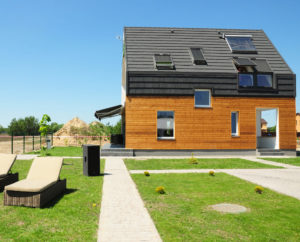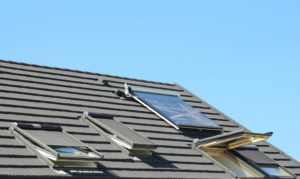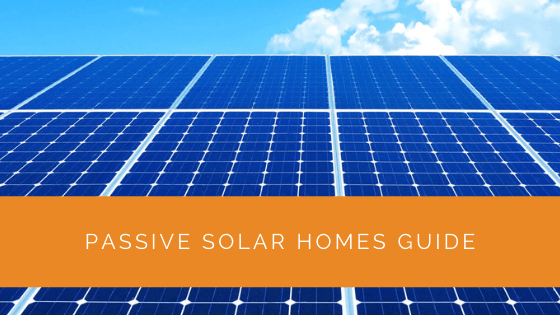What if we told you that your home could help you generate energy? Surprising, isn’t it? With the concept of passive solar homes in the picture, you can quickly get free energy from the sun. Not only does this reduce the cost you spend on energy, but it also makes the entire journey eco-friendly.
Passive solar homes are called so for the simple reason that they do not have any wires, batteries, or panels. All the focus in a passive solar home goes to the design. As astonishing as it is, passive solar homes are not a new concept.
Today, we will tell you about passive solar heating and how you can use the same in a home designed accordingly.
Contents
- 1 Key Takeaways
- 2 What Is Passive Solar Heating?
- 3 What Is a Passive Solar Home?
- 4 What Are the Elements of a Passive Solar Home?
- 5 How Does Passive Solar Heating Work?
- 6 Factors to Consider Before Buying a Passive Solar Home
- 7 Case Study: Building an Efficient Passive Solar Home
- 8 Expert Insights From Our Solar Panel Installers About Passive Solar Homes
- 9 Experience Solar Excellence with Us!
- 10 Conclusion
Key Takeaways
- Passive solar homes use design elements to harness and distribute solar energy for heating, reducing the need for traditional heating methods.
- These homes rely on features like well-placed windows, heat distribution, absorbers, and thermal mass to efficiently capture and store solar heat.
- Key considerations before adopting passive solar design include energy efficiency improvements and selecting a location with unobstructed sunlight for optimal performance.
What Is Passive Solar Heating?
For a long time, we have been heating our houses with expensive fossil fuels. We’re sure you agree that the price we pay for heat today is exceptionally high. What if we were to tell you that there is a cheaper and eco-friendly way to generate and use heat?
That would be wonderful, wouldn’t it? Well, this method of heating is called passive solar heating. The new homes of this category do not need solar panels or boilers mounted on roofs to generate heat anymore.
With the help of passive solar heating, you can collect, distribute and absorb solar energy directly through the windows of your home. Passive solar heating allows materials to hold onto heat during the day, followed by dispersing this heat at night.
With the help of such materials, you can keep your home comfortably warm. This method of heat dispensing is called passive solar heating for the simple reason that no technology or solar panels are used to generate heat. All you need is sunshine!
Passive solar heating is on the rise because it is cost-effective, convenient, and comfortable to use.
The heating process requires several steps, but the entire process helps spread warmth throughout the house.
What Is a Passive Solar Home?
With the help of some basic physical characteristics of your home, you can enhance the lighting and control the temperature. It is no secret that a passive solar design will reduce the electricity consumption and the monthly energy bill irrespective of the climate zone you reside in.
A home’s passive solar design includes the natural features of your home and surroundings that capture the sun’s rays in winter. Additionally, these features also help deflect the high sun rays in summer to keep the interior cool.
So, if you’re wondering what makes a home a passive solar home, it features elevation, materials, room layout, surrounding landscape, and the orientation of a home. A passive solar design does not mandate using electrical or mechanical devices such as fans, electrical controls, or pumps.
To run a passive solar home, you will have to use the windows, floors, and walls to store, distribute and collect solar energy as heat during the winter season and block the same in summer.
Passive solar homes come in different forms. Some passive solar homes are fully heated by the sun, and other homes have south-facing windows that allow minimal heat to enter.

What Are the Elements of a Passive Solar Home?
As you may have guessed, a passive solar home is not like a typical home. Certain elements such as huge windows, significant heat distribution, absorbers, etc., make up a passive solar home.
Below, we have collated a list of elements of passive solar design for your reference. Take a look!
Heat Distribution
A passive solar design lets the solar heat move around from storage and collection points to various parts of the house. A typical passive solar design is dependent on natural heat transfer. However, some applications in the house use fans, blowers, and ducts to help in the distribution of heat.
Absorbers
An absorber is a darkened and hard surface in the storage element responsible for absorbing the heat. This surface is present in the direct path of the rays of the sun. Generally, floors, partitions, or masonry walls work as absorbers. When the sunlight falls onto this surface, heat is absorbed.
Control
During summer, trees or hangings on the roofs can be used to generate shade for the windows. Furthermore, electronic sensing devices such as a thermostat signaling a fan to turn on, dampers, and vents allowing or restricting heat flow can also be used to control the temperature.
You can also use awnings and low-emissivity to do the same.
Windows or Aperture
Generally, windows in a passive solar home should face anywhere around 30 degrees south. The windows should not have any shade on them from morning 9 AM to noon 3 PM during the winter. Otherwise, the control will block the heat.
The living area windows must face south, and the windows in the bedrooms should face north. If you live in a cold region, you can minimize the window area on walls that essentially face east, west, and north. However, this depreciation should allow ample daylight to enter.
If you reside in a warm region, you should use windows facing north and have substantial control over the south windows.
Thermal Mass
The ideal walls and floors for passive solar homes are the ones that can easily absorb heat in colder climates. Thermal mass essentially refers to all those materials that can retain heat received from the sun.
It is essential to understand the difference between thermal mass and absorber even though they form part of the same floor or wall. The difference between the two is that the absorber comprises a surface exposed, whereas the thermal mass is the material below or behind that exposed surface.
How Does Passive Solar Heating Work?
After reading about the five elements given above, we need to see how these elements merge to operate the heating system. Typically, the passive solar heating system is a four-step process. Take a look!
- The windows facing south let the sun’s rays enter the house. This part of the heating system is called the aperture or the collector stage.
- As you may have guessed, once the energy passes through the windows, it is absorbed by the absorber, which is a dark paint coating on the thermal mass. As discussed above, the thermal mass can hold the heat.
- The solar energy absorbed by the absorber is now transferred and stored in the thermal mass that maintains heat. But what happens to the heat when the thermal mass absorbs it? With the help of passive solar heating, this stored heat is let out through radiation, convection, or conduction.
- Once the heat is liberated into the passive solar home, there has to be a way through which the heat can stay inside, keeping the temperature warm indoors. The control navigates this part of the process. The control essentially devises a mechanism through which all the heating processes start to work in unison. This includes the functions of overhanging on the roofs, sensors detecting heat problems, or vents.
To further understand the process, let’s look at what is meant by radiation, convection, and conduction.
- Radiation refers to the heat traveling in waves.
- Convection allows heat to move through the air in ragged lines on an extremely hot day.
- Conduction refers to the transfer of heat through the touch of one object with another.
When all these processes combine, a passive solar home functions effectively. It is needless to say that a passive solar heating system is one of the best investments in today’s world. Multiple studies have shown that passive solar homes help in saving money.
Interestingly, a passive solar home can save up to $150-$380 of gas per year. Alternatively, if oil is being used for heating, you will likely save approximately $210-$520 per year.

Factors to Consider Before Buying a Passive Solar Home
The idea of a passive solar home sounds appealing, but there are two essential factors that you need to think about before you add these features to your home or design a new solar home. Take a look at these factors:
Energy Efficiency
If you are truly looking for a cost-effective strategy that will help reduce energy bills, energy efficiency is the most effective strategy you can choose.
So, before you decide to give the green light to your passive solar home, look for professionals who are experienced in building energy-efficient homes. These professionals help you optimize the energy in your home and also carry out the construction accordingly.
On the other hand, if you are redesigning an existing house into a passive solar home, you need to carry out a home energy audit. This audit will help you determine and prioritize the most cost-effective energy efficiency changes that need to be made.
Selecting the Site
Selecting the place where your passive solar home is going to stand tall is the most important part of building such a home from scratch. The reason is quite apparent – you will need a lot of unobstructed sunlight.
So, when planning for a new passive solar home, the south of your home must have an unblocked view of the sun for the house to function holistically. Trees or buildings should not block this part of your home to reduce the energy you receive.
In many areas, specific land use regulations offer protection to the solar access of people. However, if you do not live in such an area, look for an area that allows you to place the house on the north end of a deep plot from north to south.
You need to understand that a passive solar heating system can only be set up in a new home. You cannot get it installed in your pre-existing home.
So, if you plan to get this system installed in your old home, you will have to get the house demolished, windows repositioned, and much more!
Case Study: Building an Efficient Passive Solar Home
Background
At Solar Panels Network USA, we are dedicated to providing sustainable energy solutions that are both innovative and practical. One of our standout projects involved the design and construction of a passive solar home for a family looking to reduce their environmental impact and energy costs.
Project Overview
The goal was to create a home that could harness and utilize solar energy efficiently for heating purposes, minimizing the need for conventional energy sources. The design needed to incorporate elements that would maximize solar gain in winter while keeping the house cool in summer.
Implementation
Site Selection and Orientation: We began by selecting a plot with a clear, unobstructed view to the south, ensuring maximum exposure to the sun throughout the year. The house was positioned to face south, with large windows strategically placed to capture sunlight during the winter months.
Design and Construction: The design incorporated key passive solar principles such as thermal mass, insulation, and natural ventilation. The flooring and walls were constructed using materials with high thermal mass, such as concrete and stone, to absorb and store heat during the day and release it at night.
Window Placement and Shading: Windows were placed to allow for optimal sunlight penetration during winter. Overhangs and shades were designed to block the high summer sun, preventing overheating while allowing low winter sun to penetrate and warm the home.
Heat Distribution and Control: Natural convection and conduction principles were employed to distribute heat evenly throughout the home. Additionally, strategic placement of vents and fans ensured proper airflow, enhancing comfort and energy efficiency.
Results
Energy Efficiency: The passive solar home demonstrated remarkable energy efficiency, reducing the need for artificial heating and cooling systems. During the winter, the home maintained comfortable temperatures with minimal use of auxiliary heating, significantly lowering energy bills.
Cost Savings: The homeowners experienced substantial savings on their energy bills, with heating costs reduced by up to 50% compared to conventional homes. The initial investment in passive solar design and materials was quickly offset by these ongoing savings.
Environmental Impact: The passive solar home contributed to a reduction in greenhouse gas emissions by minimizing reliance on fossil fuels. The design’s efficiency and reliance on renewable energy sources highlighted the potential for sustainable living.
Comfort and Aesthetics: Beyond energy savings, the homeowners enjoyed a comfortable living environment with abundant natural light and stable indoor temperatures. The design also provided an aesthetically pleasing living space that blended seamlessly with the natural surroundings.
Summary
The passive solar home project by Solar Panels Network USA exemplifies the potential of sustainable design in creating energy-efficient, environmentally friendly living spaces. By integrating key passive solar principles and leveraging natural elements, we delivered a home that not only reduced energy costs but also provided a comfortable and aesthetically pleasing living environment. This case study underscores our commitment to innovative, sustainable solutions that benefit both homeowners and the environment.
Expert Insights From Our Solar Panel Installers About Passive Solar Homes
Designing a passive solar home requires a deep understanding of local climate and architectural principles. Proper window placement and thermal mass are crucial to ensure maximum heat absorption and distribution.
Senior Solar Architect
Passive solar homes are not just about saving energy; they’re about creating a comfortable living environment that harmonizes with natural elements. The key is in the details, from materials to orientation.
Lead Solar Consultant
One of the biggest advantages of passive solar design is its simplicity and cost-effectiveness. By leveraging natural sunlight, homeowners can significantly reduce their heating and cooling costs without relying on complex systems.
Solar Installation Specialist
Experience Solar Excellence with Us!
Trust in Solar Panels Network USA, where our seasoned experts deliver top-quality solar solutions for homes and businesses nationwide. With a legacy of countless successful installations and a commitment to sustainable energy, we’re your reliable partner in the solar journey. Ready for a brighter, eco-friendly future? Call us now at (855) 427-0058 and harness the power of the sun!
Conclusion
A passive solar home is truly one of the best investments if you are looking to reduce that energy bill and move towards an environmentally friendly lifestyle. Passive solar homes are revolutionary as they lead to reduced greenhouse gas emissions.
Although such homes have been in the picture for decades, better designs and recent improvements have indeed led to an increased efficiency that is now appealing to people. However, passive solar homes require an upfront investment which is one of the reasons why these homes are not highly common.
Even though passive solar homes are not a mainstream idea as of now, they are up and coming to help reduce the ecological footprint and save lots of money!
About the Author
Solar Panels Network USA stands at the forefront of solar energy solutions, driven by a team of seasoned solar engineers and energy consultants. With over decades of experience in delivering high-quality solar installations and maintenance, we are committed to promoting sustainable energy through customer-centric, tailored solutions. Our articles reflect this commitment, crafted collaboratively by experts to provide accurate, up-to-date insights into solar technology, ensuring our readers are well-informed and empowered in their solar energy decisions.

